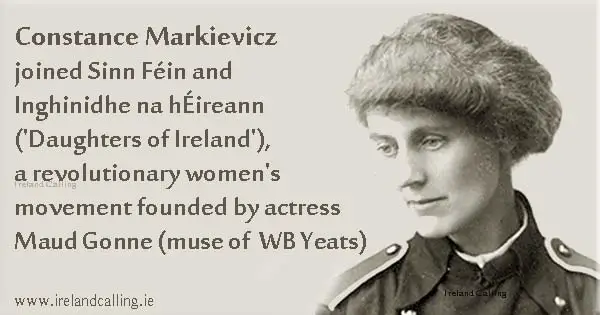One of the great heroines of Irish history, Countess Markievicz was born on 4 February 1868.
Constance Markievicz was a remarkable and influential woman and was a vital player in several important moments of Ireland’s history.
She was a founder member of Fianna Éireann, Cumann na mBan and the Irish Citizen Army.

She was also the first ever woman to be elected into British parliament – but did not take her seat as it would undermine Ireland’s bid for independence.
Markievicz was born Constance Gore-Booth. She grew up in a wealthy family and her father Sir Henry Gore-Booth was a landlord.
Unlike the stereotypical cruel landlords, Sir Henry was compassionate towards the poor and provided food for his tenants during the famine of 1879-80.
This helped to establish a strong social conscience in the young Constance.
As a young adult she trained to be a painter and spent time living in London and Paris (where she met her husband) before settling in Dublin.
She spent the early part of the 20th century in the company of Dublin’s artistic community.
During this time, she gradually developed an interest in nationalist politics. She joined Sinn Féin and founded the nationalist youth organisation Fianna Éireann.
Markievicz later joined the Irish Citizen Army, which was founded by James Connolly, who would become an inspirational figure to her.
In 1916, Connolly was one of the seven leaders of the Easter Rising.
Markievicz played a key role in the uprising. It is known that she fought the British on St Stephen’s Green. However, there are differing accounts as to her actions.
Some accounts say that she killed an unarmed policeman in the first morning of the uprising. However, others say she was at City Hall at the time and arrived at St Stephen’s Green later in the afternoon.
Either way, she played an important role for the rebels and was in charge of setting up barricades in St Stephen’s Green and she wounded a British sniper.
Markievicz was arrested and sentenced to death, but this was downgraded to life imprisonment because she was a woman.
When she heard of her sentence she said: “I do wish your lot had the decency to shoot me.”
In 1917, she was released from prison as part of an amnesty for those who had taken part in the Easter Rising.
The following year she became an MP when she stood for Sinn Féin in the constituency of Dublin St Patrick’s.
Sinn Féin won 73 of 105 Irish seats and refused to sit in the British House of Commons. Instead they formed the Dáil Éireann – parliament in Ireland.
This was outlawed by the British and the MPs had to meet in secret. Markievicz was the Minister for Labour in the Second and third ministries of the Dáil from 1919-1921.
This made her the first ever Irish female cabinet minister and only the second female minister in Europe.
During the Irish Civil War she fought for the Anti-Treaty IRA along with Éamon de Valera.
In 1926, Markievicz returned to politics and joined the newly established Fianna Fáil. She was elected to the 5th Dáil but passed away from issues related to appendicitis five weeks before she could take her seat.
Markievicz died in 1927 and was buried at Dublin’s Glasnevin Cemetery. De Valera, who was then leader of Fianna Fáil spoke at her funeral.
More popular articles
https://irishhistorybitesize.com/modern/varadkar-united-ireland/
https://irishhistorybitesize.com/modern/bullying-british-demands-over-irish-border/
https://irishhistorybitesize.com/modern/british-prime-minister-theresa-may-warns-of-a-united-ireland-if-theres-a-no-deal-brexit/
https://irishhistorybitesize.com/modern/irish-taoiseach-shreds-british-prime-minister/
https://irishhistorybitesize.com/modern/100-years-ago-border-ireland-bring-down-government/
https://irishhistorybitesize.com/uncategorized/brexit-northern-ireland/
https://irishhistorybitesize.com/modern/brexit/
https://irishhistorybitesize.com/modern/british-politician-clanger/